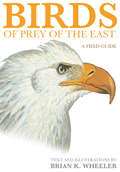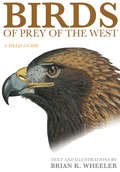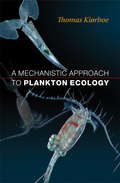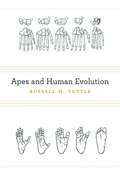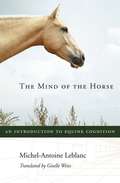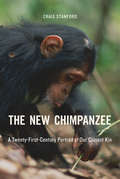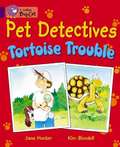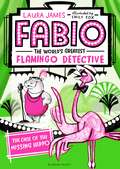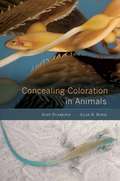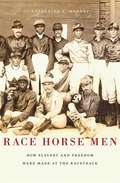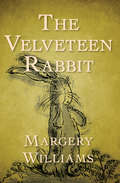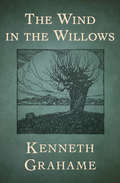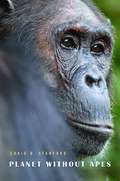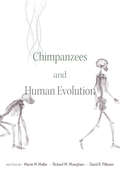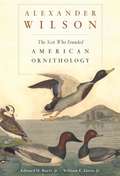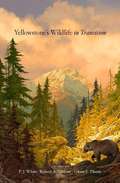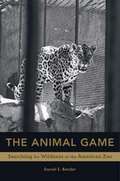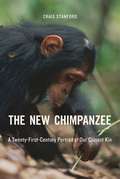- Table View
- List View
Dog Man Unleashed (Dog Man)
by Dav PilkeyIt's a leg-crossing mission into laughter for the death-defying duo of Super Diaper Baby and Diaper Dog - complete with action, chuckles and fantastic flip-e-rama! No baddie wants to mess with Super Diaper Baby. This wee superhero is faster than a speeding stroller, more powerful than diaper rash, and able to leap tall buildings without making poopy stinkers! He's the first newborn ever to stomp on evil baddies without getting his diaper dirty. And now our nappy-clad hero and his trusty sidekick, Diaper Dog, have a new villain to tackle! Dr Dilbert Dinkle started his career as an ordinary evil genius and bank robber. But when he awakens one day transformed into a walking, talking puddle of pee, he vows to destroy every toilet in town. Will the devious Dr Dinkle succeed in ruining restrooms for the rest of us? Or can Super Diaper Baby save widdling for the world? <P><P><i>Advisory: Bookshare has learned that this book offers only partial accessibility. We have kept it in the collection because it is useful for some of our members. To explore further access options with us, please contact us through the Book Quality link. Benetech is actively working on projects to improve accessibility issues such as these.</i>
Big Pacific: Passionate, Voracious, Mysterious, Violent
by Rebecca TansleyThe Pacific Ocean covers one-third of Earth’s surface—more than all of the planet’s landmasses combined. It contains half of the world’s water, hides its deepest places, and is home to some of the most dazzling creatures known to science. The companion book to the spectacular five-part series on PBS produced by Natural History New Zealand, Big Pacific breaks the boundaries between land and sea to present the Pacific Ocean and its inhabitants as you have never seen them before.Illustrated in full color throughout, Big Pacific blends a wealth of stunning Ultra HD images with spellbinding storytelling to take you into a realm teeming with exotic life rarely witnessed up close—until now. The book is divided into four sections, each one focusing on an aspect of the Pacific. "Passionate Pacific" looks at the private lives of sea creatures, with topics ranging from the mating behaviors of great white sharks to the monogamy of wolf eels, while "Voracious Pacific" covers hunting and feeding. In "Mysterious Pacific," you will be introduced to the Pacific’s more extraordinary creatures, like the pufferfish and firefly squid, and explore some of the region’s eerier locales, like the turtle tombs of Borneo and the skull caves of Papua New Guinea. "Violent Pacific" examines the effects of events like natural disasters on the development of the Pacific Ocean’s geography and the evolution of its marine life.Providing an unparalleled look at a diverse range of species, locations, and natural phenomena, Big Pacific is truly an epic excursion to one of the world’s last great frontiers.Five-part series on PBS:Big Pacific will air Wednesdays on PBS, June 21-July 19, 2017
Dork Diaries: Puppy Love
by Rachel Renée RussellWhen the animal shelter Brandon volunteers at is too full to take a litter of abandoned puppies, Nikki decides to look after them until the shelter has more room. Simple. There's only one slight problem... her parents won't allow dogs in the house so Nikki has to hide them at home and take them to school in secret. But with seven puppies to hide, things are going to get messy... Is Nikki's plan going to end in a pawfully dorky disaster? The brand NEW instalment from the internationally bestselling DORK DIARIES series, from Rachel Renée Russell, author of The Misadventures of Max Crumbly (June 2016). Perfect for fans of Wimpy Kid, Tom Gates, Jacqueline Wilson and James Patterson.
Birds of Prey of the East: A Field Guide
by Brian K. WheelerBirds of Prey of the East and its companion volume, Birds of Prey of the West, are the most comprehensive and authoritative field guides to North American birds of prey ever published. Written and lavishly illustrated with stunning, lifelike paintings by leading field-guide illustrator, photographer, and author Brian Wheeler, the guides depict an enormous range of variations of age, sex, color, and plumage, and feature a significant amount of plumage data that has never been published before. The painted figures illustrate plumage and species comparisons in a classic field-guide layout. Each species is shown in the same posture and from the same viewpoint, which further assists comparisons. Facing-page text includes quick-reference identification points and brief natural history accounts that incorporate the latest information. The range maps are exceptionally accurate and much larger than those in other guides. They plot the most up-to-date distribution information for each species and include the location of cities for more accurate reference. Finally, the guides feature color habitat photographs next to the maps. The result sets a new standard for guides to North America's birds of prey.Lavishly illustrated with stunning, lifelike paintingsWritten and illustrated by a leading authority on North American birds of preyDepicts more plumages than any other guideConcise facing-page text includes quick-reference identification pointsClassic field-guide layout makes comparing species easyLarge, accurate range maps include up-to-date distribution informationUnique color habitat photographs next to the maps
Birds of Prey of the East: A Field Guide
by Brian K. WheelerBirds of Prey of the East and its companion volume, Birds of Prey of the West, are the most comprehensive and authoritative field guides to North American birds of prey ever published. Written and lavishly illustrated with stunning, lifelike paintings by leading field-guide illustrator, photographer, and author Brian Wheeler, the guides depict an enormous range of variations of age, sex, color, and plumage, and feature a significant amount of plumage data that has never been published before. The painted figures illustrate plumage and species comparisons in a classic field-guide layout. Each species is shown in the same posture and from the same viewpoint, which further assists comparisons. Facing-page text includes quick-reference identification points and brief natural history accounts that incorporate the latest information. The range maps are exceptionally accurate and much larger than those in other guides. They plot the most up-to-date distribution information for each species and include the location of cities for more accurate reference. Finally, the guides feature color habitat photographs next to the maps. The result sets a new standard for guides to North America's birds of prey.Lavishly illustrated with stunning, lifelike paintingsWritten and illustrated by a leading authority on North American birds of preyDepicts more plumages than any other guideConcise facing-page text includes quick-reference identification pointsClassic field-guide layout makes comparing species easyLarge, accurate range maps include up-to-date distribution informationUnique color habitat photographs next to the maps
Birds of Prey of the West: A Field Guide
by Brian K. WheelerBirds of Prey of the West and its companion volume, Birds of Prey of the East, are the most comprehensive and authoritative field guides to North American birds of prey ever published. Written and lavishly illustrated with stunning, lifelike paintings by leading field-guide illustrator, photographer, and author Brian Wheeler, the guides depict an enormous range of variations of age, sex, color, and plumage, and feature a significant amount of plumage data that has never been published before. The painted figures illustrate plumage and species comparisons in a classic field-guide layout. Each species is shown in the same posture and from the same viewpoint, which further assists comparisons. Facing-page text includes quick-reference identification points and brief natural history accounts that incorporate the latest information. The range maps are exceptionally accurate and much larger than those in other guides. They plot the most up-to-date distribution information for each species and include the location of cities for more accurate reference. Finally, the guides feature color habitat photographs next to the maps. The result sets a new standard for guides to North America's birds of prey.Lavishly illustrated with stunning, lifelike paintingsWritten and illustrated by a leading authority on North American birds of preyDepicts more plumages than any other guideConcise facing-page text includes quick-reference identification pointsClassic field-guide layout makes comparing species easyLarge, accurate range maps include up-to-date distribution informationUnique color habitat photographs next to the maps
Birds of Prey of the West: A Field Guide
by Brian K. WheelerBirds of Prey of the West and its companion volume, Birds of Prey of the East, are the most comprehensive and authoritative field guides to North American birds of prey ever published. Written and lavishly illustrated with stunning, lifelike paintings by leading field-guide illustrator, photographer, and author Brian Wheeler, the guides depict an enormous range of variations of age, sex, color, and plumage, and feature a significant amount of plumage data that has never been published before. The painted figures illustrate plumage and species comparisons in a classic field-guide layout. Each species is shown in the same posture and from the same viewpoint, which further assists comparisons. Facing-page text includes quick-reference identification points and brief natural history accounts that incorporate the latest information. The range maps are exceptionally accurate and much larger than those in other guides. They plot the most up-to-date distribution information for each species and include the location of cities for more accurate reference. Finally, the guides feature color habitat photographs next to the maps. The result sets a new standard for guides to North America's birds of prey.Lavishly illustrated with stunning, lifelike paintingsWritten and illustrated by a leading authority on North American birds of preyDepicts more plumages than any other guideConcise facing-page text includes quick-reference identification pointsClassic field-guide layout makes comparing species easyLarge, accurate range maps include up-to-date distribution informationUnique color habitat photographs next to the maps
A Mechanistic Approach to Plankton Ecology
by Thomas KiørboeThe three main missions of any organism--growing, reproducing, and surviving--depend on encounters with food and mates, and on avoiding encounters with predators. Through natural selection, the behavior and ecology of plankton organisms have evolved to optimize these tasks. This book offers a mechanistic approach to the study of ocean ecology by exploring biological interactions in plankton at the individual level. The book focuses on encounter mechanisms, since the pace of life in the ocean intimately relates to the rate at which encounters happen. Thomas Kiørboe examines the life and interactions of plankton organisms with the larger aim of understanding marine pelagic food webs. He looks at plankton ecology and behavior in the context of the organisms' immediate physical and chemical habitats. He shows that the nutrient uptake, feeding rates, motility patterns, signal transmissions, and perception of plankton are all constrained by nonintuitive interactions between organism biology and small-scale physical and chemical characteristics of the three-dimensional fluid environment. Most of the book's chapters consist of a theoretical introduction followed by examples of how the theory might be applied to real-world problems. In the final chapters, mechanistic insights of individual-level processes help to describe broader population dynamics and pelagic food web structure and function.
Alexander Wilson: The Scot Who Founded American Ornithology
by Edward H. Burtt Jr.On the bicentennial of his death, this beautifully illustrated volume pays tribute to the Scot who became the father of American ornithology. Alexander Wilson made unique contributions to ecology and animal behavior. His drawings of birds in realistic poses in their natural habitat inspired Audubon, Spencer Fullerton Baird, and other naturalists.
Apes and Human Evolution
by Russell H. TuttleIn this masterwork, Russell H. Tuttle synthesizes a vast research literature in primate evolution and behavior to explain how apes and humans evolved in relation to one another, and why humans became a bipedal, tool-making, culture-inventing species distinct from other hominoids. Along the way, he refutes the theory that men are essentially killer apes--sophisticated but instinctively aggressive, destructive beings. Situating humans in a broad context, Tuttle musters evidence from morphology and recent fossil discoveries to reveal what early primates ate, where they slept, how they learned to walk upright, how brain and hand anatomy evolved simultaneously, and what else happened evolutionarily to cause humans to diverge from their closest relatives. Despite our genomic similarities with bonobos, chimpanzees, and gorillas, humans are unique among primates in occupying a symbolic niche of values and beliefs based on symbolically mediated cognitive processes. Although apes exhibit behaviors that strongly suggest they can think, salient elements of human culture--speech, mating proscriptions, kinship structures, and moral codes--are symbolic systems that are not manifest among apes. This encylopedic volume is both a milestone in primatological research and a critique of what is known and yet to be discovered about human and ape potential.
The Mind of the Horse: An Introduction To Equine Cognition
by Michel-Antoine LeblancHorses were first domesticated about 6,000 years ago on the vast Eurasian steppe, yet only in the last two decades have scientists begun to explore the mental capacities of these animals. In The Mind of the Horse, Michel-Antoine Leblanc presents an encyclopedic synthesis of scientific knowledge about equine behavior and cognition, providing experts and enthusiasts alike with an up-to-date understanding of how horses perceive, think about, and adapt to their physical and social worlds. Much of what we think we know about "the intelligence of the horse" derives from fragmentary reports and anecdotal evidence. Putting this accumulated wisdom to the test, Leblanc introduces readers to rigorous experimental investigations into how horses make sense of their world under varying conditions. He describes the anatomical and neurophysiological characteristics of the horse's brain, and compares these features with those of other species, to gain an evolutionary perspective. A horseman himself, Leblanc also considers the opinions of renowned riding masters, as well as controversies surrounding the horse's extraordinary mental powers that have stirred in equestrian and scientific circles. The Mind of the Horse brings together in one volume the current state of equine research and will likely stimulate surprising new discoveries.
The New Chimpanzee: A Twenty-First-Century Portrait of Our Closest Kin
by Craig StanfordRecent discoveries about wild chimpanzees have dramatically reshaped our understanding of these great apes and their kinship with humans. We now know that chimpanzees not only have genomes similar to our own but also plot political coups, wage wars over territory, pass on cultural traditions to younger generations, and ruthlessly strategize for resources, including sexual partners. In The New Chimpanzee, Craig Stanford challenges us to let apes guide our inquiry into what it means to be human. With wit and lucidity, Stanford explains what the past two decades of chimpanzee field research has taught us about the origins of human social behavior, the nature of aggression and communication, and the divergence of humans and apes from a common ancestor. Drawing on his extensive observations of chimpanzee behavior and social dynamics, Stanford adds to our knowledge of chimpanzees’ political intelligence, sexual power plays, violent ambition, cultural diversity, and adaptability. The New Chimpanzee portrays a complex and even more humanlike ape than the one Jane Goodall popularized more than a half century ago. It also sounds an urgent call for the protection of our nearest relatives at a moment when their survival is at risk.
Pet Detectives: Tortoise Trouble (PDF) (Collins Big Cat Ser. (PDF))
by Jana Hunter Cliff Moon Kim Blundell Collins Big Cat StaffThe Pet Detective faces a special challenge when Kara’s pet tortoise, Rocket, goes missing. Has the tortoise been squashed on a motorway? Eaten by a hungry goat? Chewed up by a dog? The Pet Detective follows the clues to find out what’s happened. • Purple/ Band 8 books offer developing readers literary language, with some challenging vocabulary. • Text type - A story by the same author. • A final double page spread shows all the things a Pet Detective needs on a case to support recapping the story. • Curriculum links - Science: Plants and animals in the local environment. • Tortoise Trouble is one of two stories by Jana Hunter about the Pet Detective • This book has been levelled for Reading Recovery.
Fabio The World's Greatest Flamingo Detective: The Case of the Missing Hippo
by Laura James'Zany ... Even reluctant readers will have a blast' IRISH TIMES In a small town on the banks of Lake Laloozee lives the world's greatest flamingo detective. His name is Fabio. He's not tall or strong, but slight and pink. And he's very, very clever.When Fabio and his giraffe associate Gilbert (terrible at disguises) drop in to the Hotel Royale for a lemonade (pink, naturally), Fabio is persuaded to judge the hotel's talent contest. But when the most promising contestant – Julia the jazz-singing hippopotamus – goes missing, Fabio must put his thinking cap back on and solve the mystery!This new mystery series from Laura James, author of Captain Pug, will have animal lovers and would-be detectives in stitches. Perfect for fans of Claude, Foxy Tales and The Pink Panther!
Concealing Coloration in Animals
by Judy DiamondColor can attract mates, intimidate enemies, and distract predators. But it can also conceal animals from detection. It is an adaptation to the visual features of the environment but also to the perceptual and cognitive capabilities of other organisms. Judy Diamond and Alan Bond reveal factors at work in the evolution of concealing coloration.
Race Horse Men: How Slavery And Freedom Were Made At The Racetrack
by Katherine C. MooneyKatherine C. Mooney recaptures the sights, sensations, and illusions of America's first mass spectator sport. Her central characters are not the elite white owners of slaves and thoroughbreds but the black jockeys, grooms, and horse trainers who called themselves race horse men and made the racetrack run--until Jim Crow drove them from their jobs.
The Velveteen Rabbit
by Margery WilliamsMargery Williams’s magical nursery tale of a stuffed rabbit and his quest to become real Christmas morning, the room filled with the hustle and bustle of preparation, a rabbit stitched of velveteen sits perched on top of the little boy’s stocking. Those first two hours are the best of the young rabbit’s life: filled with hugs and play. But like most children, the boy is fickle and easily distracted—after Christmas morning, the Velveteen Rabbit is forgotten. Shy and intimidated by the new mechanical toys who sneer at him for being simple, the sawdust-filled rabbit sits quietly at the top of the toy closet, aching to be loved the way he was that wonderful Christmas morning. He’s soon taken in by the wise old Skin Horse, who sets him straight on the way to become real. It’s not about expensive mechanisms or shiny paint jobs. No, becoming real is all about the unadulterated love of a child. The Velveteen Rabbit is a timeless story about the importance of love, honesty, and friendship. This ebook has been professionally proofread to ensure accuracy and readability on all devices.
The Wind in the Willows
by Kenneth GrahameThe classic story of Mole, Rat, Toad, Badger and the wonderful adventures they share As spring begins to bloom across the countryside, so too does Mole’s desire to leave his underground home and venture into the wilds above. His journey delivers him to the banks of a river—the first Mole has ever seen—and to the blue-and-white boat captained by Rat. Their camaraderie sparked, Mole and Rat continue into the Wild Wood, meeting up with the cantankerous Badger and the impulsive Toad. No stranger to calamity, Toad and his reckless habits—including a tendency toward spectacular car crashes—will get the four friends into heaps of trouble, but their steadfast loyalty to one another always sees them through.The Wind in the Willows is a charming, unforgettable ode to friendship and one of the most cherished children’s stories of all time. This ebook has been professionally proofread to ensure accuracy and readability on all devices.
Planet Without Apes
by Craig B. StanfordCan we live with the consequences of wiping our closest relatives off the face of the Earth, and all the biological knowledge about ourselves that would die along with them? Extinction of the great apes threatens to become a reality within a few human generations. Stanford tells us how we can redirect the course of an otherwise bleak future.
Chimpanzees and Human Evolution
by Martin N. MullerKnowledge of wild chimpanzees has expanded dramatically. This volume, edited by Martin Muller, Richard Wrangham, and David Pilbeam, brings together scientists who are leading a revolution to discover and explain human uniqueness, by studying our closest living relatives. Their conclusions may transform our understanding of human evolution.
Alexander Wilson: The Scot Who Founded American Ornithology
by Edward H. Burtt Jr.On the bicentennial of his death, this beautifully illustrated volume pays tribute to the Scot who became the father of American ornithology. Alexander Wilson made unique contributions to ecology and animal behavior. His drawings of birds in realistic poses in their natural habitat inspired Audubon, Spencer Fullerton Baird, and other naturalists.
Yellowstone's Wildlife in Transition
by P. J. WhiteThe world's first national park is constantly changing. How we understand and respond to recent events putting species under stress will determine the future of ecosystems millions of years in the making. Marshaling expertise from over 30 contributors, Yellowstone's Wildlife in Transition examines three primary challenges to the park's ecology.
Bee Time: Lessons from the Hive
by Mark L. WinstonBeing among bees is a full-body experience, Mark Winston writes. Bee Time presents his reflections on three decades spent studying these remarkable creatures, and on the lessons they can teach about how humans might better interact with one another and the natural world, from the boardroom to urban design to agricultural ecosystems.
The Animal Game: Searching For Wildness At The American Zoo
by Daniel E. BenderTracing the global trade and trafficking in animals that supplied U.S. zoos, Daniel Bender shows how Americans learned to view faraway places through the lens of exotic creatures on display. He recounts the public’s conflicted relationship with zoos, decried as prisons by activists even as they remain popular centers of education and preservation.
The New Chimpanzee: A Twenty-First-Century Portrait of Our Closest Kin
by Craig StanfordRecent discoveries about wild chimpanzees have dramatically reshaped our understanding of these great apes and their kinship with humans. We now know that chimpanzees not only have genomes similar to our own but also plot political coups, wage wars over territory, pass on cultural traditions to younger generations, and ruthlessly strategize for resources, including sexual partners. In The New Chimpanzee, Craig Stanford challenges us to let apes guide our inquiry into what it means to be human. With wit and lucidity, Stanford explains what the past two decades of chimpanzee field research has taught us about the origins of human social behavior, the nature of aggression and communication, and the divergence of humans and apes from a common ancestor. Drawing on his extensive observations of chimpanzee behavior and social dynamics, Stanford adds to our knowledge of chimpanzees’ political intelligence, sexual power plays, violent ambition, cultural diversity, and adaptability. The New Chimpanzee portrays a complex and even more humanlike ape than the one Jane Goodall popularized more than a half century ago. It also sounds an urgent call for the protection of our nearest relatives at a moment when their survival is at risk.



